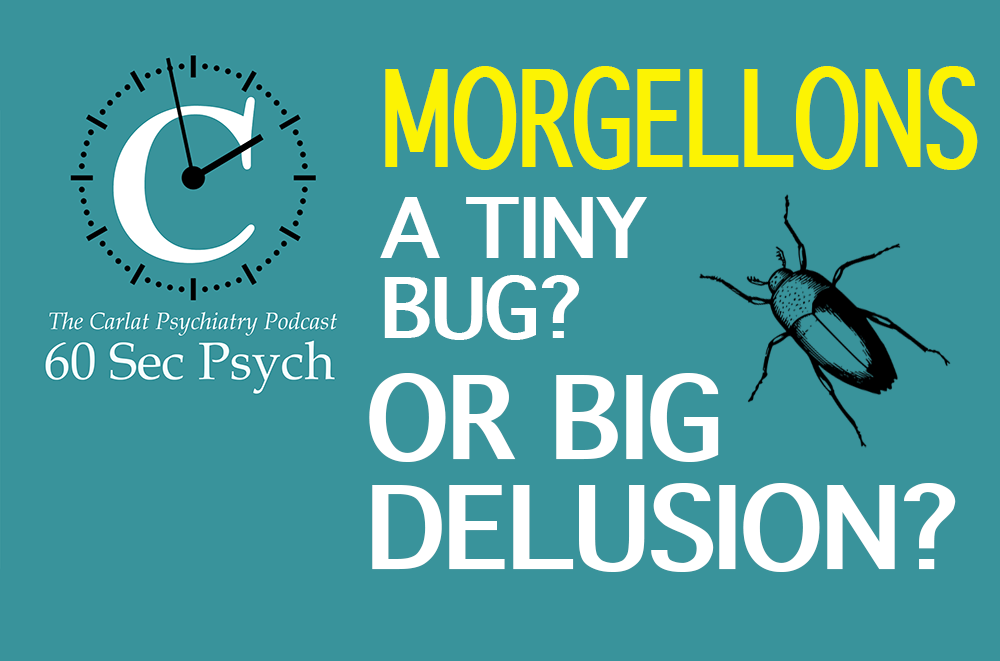Morgellons: A Tiny Bug or a Big Delusion?
, Volume , Number ,
https://www.thecarlatreport.com/#
If you haven’t seen a patient with Morgellons yet, it’s a good guess that you soon will. Patients with this syndrome experience crawling, biting, and stinging sensations in the skin. Published On: 9/16/2020 Duration: 8 minutes, 4 seconds Transcript: If you haven’t seen a patient with Morgellons yet, it’s a good guess that you soon will. The disorder was named in 2002 by Mary Leitao, a former lab technician whose son complained of bugs under his skin. She had gone to numerous specialists who diagnosed delusional parasitosis or even f Munchausen’s by prox. Frustrated, Mary dug into medical history and found reports from 1656 by Thomas Browne who described a condition he called Morgellons where children broke out with harsh black hairs on their back. Since Mary had found multi colored fibers in her son’s sores, she adopted the name and created a website which attracted thousands of followers. In the coming years the lobbied congress and the CDC to investigate with the help of singer Joni Mitchell who also identifies with the illness. Patients with this syndrome experience crawling, biting, and stinging sensations in the skin. They present to dermatologists with skin lesions like rashes or sores and complain of fibers emerging from their skin, often bringing Ziploc bags of skin samples with them. Most dermatologists believe these are just clothing fibers that got embedded in self-imposed sores, and studies at the Centers for Disease Control – CDC – and the Mayo Clinic originally concluded the same, finding that the fibers were cotton in orgin. After the CDC report came out in 2012, Mary Leitao retreated from public life and the Morgellons website transitioned to other hands. But a small group of clinicians and researchers took up the mantel. The main players here are Randy Wymore, a pharmacologist at Oklahoma State University, Virginia Ginger Savely, a family nurse practitioner; Raphael Stricker, an internist in California, and Marianne Middelveen, a Veterinary Microbiologist in Canada. And their argument is that these fibers are not fragments of clothing but are part of an inflammatory reaction to a spirochete infection, that’s the spiral shaped family of bacteria like syphilis and the controversial Lyme disease. Virginia Savely carved out a specialty in Lyme disease and published a paper with Dr. Stricker claiming that 97% of the Morgellons patients they saw tested positive for the Borrelia spirochete that causes Lyme’s disease. This caught the attention of Dr. Middelveen, the Veterinary Microbiologist, who concluded that the fibers were not made of cotton but rather of keratin and collagen and most likely likely produced by epithelial cells in the skin. But why would the skin start producing them? Dr. Middelveen hypothesized that it was a reaction to a spirochetal infection. And why were these hairs blue? Melanin pigmentation was Dr. Middelveen’s conclusion n, admitting that some of the fibers were from clothing, plastic and dust that got imbedded in the skin. One problem with this research is that they use their own criteria to diagnose Lyme disease, which greatly inflates the diagnosis. One of their studies found a 90% rate of Lyme disease in Morgellon’s patients, but the rate was only 10% when the CDC criteria were used. This discrepancy of definitions seeps into psychiatric practice, where patients often present with a diagnosis of Lyme disease made by an alternative medicine provider. Rather than taking sides on this issue I’ll suggest these patients look at both sides of the controversy and make up their own minds. QuackWatch gives a more skeptical view of overblown medical claims and has a good section on Lyme disease. The other problem is that most of the papers supporting the infectious cause of Morgellons come from this small group of researchers, only one of whom is a physician. And some of these writers have had struggles with scientific ethics. Dr. Stricker, M.D. was accused of falsifying data by the National Institutes of Health in 1993. His paper claimed to have identified a antibody to the HIV virus that was found only in homosexual patients. It was published in the New England Journal of Medicine in 1985, was retracted. The debacle caused Dr. Stricker to lose his post at UC San Francisco, set loose from academia he tried out new pursuits, including directing a penis enlargement clinic before starting a Lyme Disease specialty clinic in San Francisco. Dr. Stricker has published many of the articles on the Lyme-Morgellons connection along with nurse practioners he employes, starting with Ginger Savely. Ms Savely came to work with Dr. Stricker after being reprimanded by the State of Texas for practicing outside the standards of care in her Lyme Disease specialty clinic where she placed patients on long-term antibiotic therapy for a reported $500 a visit. In 2011 Kamala Harris, who was then attorney general of California and now a vice presidential candidate, publically reprimanded Ms. Savely for similar problems. So what do you do when a patient presents with unexplained skin lesions, fibrous strands, and complaints of bugs crawling under their skin? First, establish a working alliance – not an easy feat in these cases but one that Michael Posternak tackled in this Monday’s podcast. Next, check for dopaminergic agents which can often cause formication or the feeling of bugs crawling in the skin. Stimulants, cocaine, but also meds for restless leg syndrome like pramipexole and even aripiprazole, buproprion and the modafinils which have mild dopaminergic effects. Finally, consider an antipsychotic, and our online issue has guidance on that step. References: Got feedback? Take the podcast survey.




Leave A Comment
You must be logged in to post a comment.